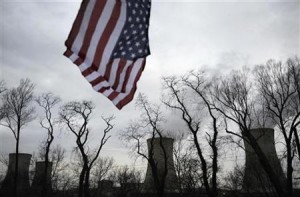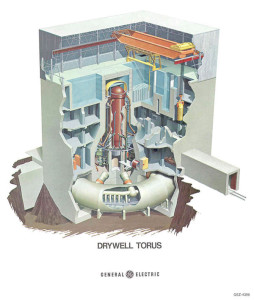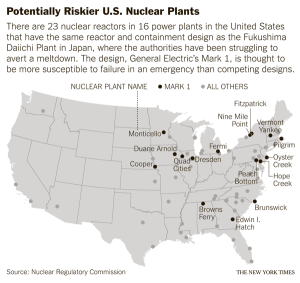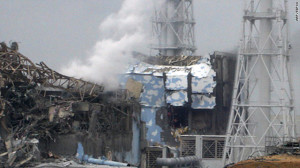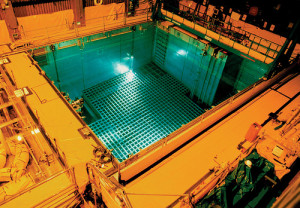The video embedded below, along with the draft script and supporting links, can be freely…
Soft Spot: How to Quickly and Easily Destroy the United States of America
by Dan Allen, a high school Chemistry teacher in New Jersey, as well as a concerned father, organic farmer, and community garden organizer.
“The spent fuel stored in pools holds between 5 and 10 times more long-lived radioactivity than the reactor cores themselves hold. Because they were intended to be temporary, the pools do not have the same ‘defense in depth’ features that the NRC requires of reactors.” — Robert Alvarez (2012, http://www.ips-dc.org/reports/improving_spent-fuel_storage_at_nuclear_reactors)
“[T]he possibility of a terrorist attack…is speculative and simply too far removed from the natural or expected consequences of agency action…” — The Nuclear Regulatory Commission (2002) (quoted in http://www.princeton.edu/sgs/publications/sgs/pdf/11_1Alvarez.pdf)
“If the water were to drain entirely from a spent fuel pool, it could trigger a catastrophic radioactive fire that would spew toxins and render hundreds of thousands of square miles uninhabitable.” — Robert Alvarez (2011, http://www.ips-dc.org/reports/spent_nuclear_fuel_pools_in_the_us_reducing_the_deadly_risks_of_storage)
Summary: (grim satire) Ever consider destroying the US? This essay offers a quick, easy way to render much of the nation uninhabitable. (Spoiler alert: Just drain the cooling water from the lightly-secured, self-igniting spent-fuel pools of the nation’s 23 Fukushima-type nuclear reactors!) Includes reactor diagrams and maps to your conveniently-located targets!
References:
• Robert Alvarez (2012) “Improving Spent-Fuel Storage at Nuclear Reactors”, http://www.ips-dc.org/reports/improving_spent-fuel_storage_at_nuclear_reactors
• Robert Alvarez (2011) “Spent Nuclear Fuel Pools in the US: Reducing the Deadly Risks of Storage”, http://www.ips-dc.org/reports/spent_nuclear_fuel_pools_in_the_us_reducing_the_deadly_risks_of_storage
• Robert Alvarez (2003) “Reducing the Hazards from Stored Spent Power-Reactor Fuel in the United States”, http://www.princeton.edu/sgs/publications/sgs/pdf/11_1Alvarez.pdf
• Arnie Gunderson (2012) “Can Spent Fuel Pools Catch Fire?” (video) http://www.fairewinds.com/content/can-spent-fuel-pools-catch-fire
• Arnie Gunderson (2012) “More Lessons from Fukushima Daiichi” (video), http://www.fairewinds.com/content/more-lessons-fukushima-daiichi-accident-containment-failures-and-loss-ultimate-heat-sink
• Bulletin of the Atomic Scientists report (2003), “The NRC’s Dirty Little Secret: The Nuclear Regulatory Commission is still unwilling to respond to serious security problems.”, http://www.thebulletin.org/files/NRCsDirtyLittleSecretHirschLockbaumLymanMay2003.pdf
• Nuclear Information and Resource Service (NIRS) (2011) “Hazards of Boiling Water Reactors in the United States”, http://www.nirs.org/factsheets/bwrfact.htm
• National Resources Defense Council’s interactive fallout map: http://www.nrdc.org/nuclear/fallout/
• General nuclear info and activism: http://www.nirs.org/, http://www.fairewinds.com/, http://www.beyondnuclear.org/
WHEREFORE DESTRUCTION?
OK, so you’ve opened this ‘destroy the US’ link, huh? … Bold move.
But since you’ve come this far, I’m assuming two things about you: (1) You don’t mind being on an FBI watch list, and (2) you’re at least curious as to how one might ‘quickly and rapidly’ destroy a huge, armed-to-the-teeth industrial nation. Heck, maybe you’re even toying with the idea.
But before we get to the ‘how’, I want to ask you to think briefly about the ‘why’ and ‘what’ of your incipient plans of destruction. Namely, I’d just like you to clarify (if only for yourself) some of the reasons you might be considering such a bold project, as well as just what you’ll be destroying should you succeed.
We wouldn’t want to stumble forward blindly here, now would we?
As for your reasons, well, I suppose we could take our pick, huh? Maybe you object to the various US military and ‘nation building’ escapades in certain foreign countries you hold dear. Or maybe you object to what you perceive as unfair economic arm-twisting and ‘resource grabs’ in various smaller republics of your liking. Or maybe you simply wish to blunt or nullify some economic or military competition from the US in favor of your more preferred foreign governments or corporations. Or maybe you’re just nuts.
Hey, lots of reasons!
… And just what will you be destroying with this plan should this plan be successful? Wow, lots of stuff! It’s a really big country with a lot of people, and you could really polish off a huge chunk of it if you follow the directions here. And the cool part is that it’s not just the people here and now that you could destroy — no, it’d be messed up for centuries. And, of course, there are a lot of other living things here too, and I bet a good bit of them would get trashed as well. Bonus points!
And as you’ll see, it’s actually really easy to do!
BUT C’MON, ISN’T SLOW DESTRUCTION ENOUGH?
OK, so I’m glad we got the ‘why’ and ‘what’ parts of your destruction plans straight. It’s important to think things through at least a little bit — especially when one’s dealing with the destruction of entire countries.
But before we get to the ‘how’ and maybe actually implement your quick and easy plan of rapid destruction, you should probably be aware that the US is, in fact, already engineering its own destruction on several fronts. Granted, it’s occurring in a perhaps overly drawn-out manner at the moment — but, wow, it sure seems to be gaining momentum!
And how, you say? Did someone mention ‘unlivable climate’ or ‘nation-sized radiation exclusion zone’? Ha ha ha. That’s right, the US is well on its way to being a nation of uninhabitable, radioactive sand dunes, acidified-sea to shining acidified-sea. A combination of (1) accelerating climate change (driven by record global CO2 emissions and mounting exponential positive feedbacks from the earth system) and (2) deteriorating nuclear plant stability (due to aging plant infrastructure, dangerously crowded on-plant stockpiling of spent-fuel, climate destabilization, increased profit-driven short-cutting of already-insufficient safety regulations, and an emerging economic collapse) are daily increasing the odds of uninhabitability even a few decades hence.
Now, that’s a big claim, so if you’d like to research this a bit, check out the links in this essay: http://www.energybulletin.net/stories/2012-12-10/extirpation-nation-how-much-of-the-us-will-be-habitable-in-50-years.
The problem, of course, is that this self-immolation/irradiation may take decades. And for a Type-A personality like yourself, that’s way too long! You want the USA destroyed … and you want it now!!
Ha ha ha! But hold on there, tiger. First we have a wee bit of research to do…
PICKING THE RIGHT TARGET
Seeing as you might get just one shot at this, you’ll want to make sure you do it right. And that means picking the right targets. And that’s a tall order, since the requirements are a bit daunting. The targets must be: (1) easily accessible, (2) lightly guarded, and (3) capable of wreaking great destruction with only minimal prodding on your part. In other words, we need soft targets that will do most of the dirty destructive work for us.
Luckily, the US has many such targets: the twenty-three Mark I Boiling Water Nuclear Reactors – known more commonly as “the kind that blew up in Fukushima.” See Figure 1 (below) for what they look like on the inside before they blow up. (Google the gory pictures of the Fukushima reactors to see what these beauties look like after they blow up. Spoiler alert: Sort of more opened-up, crumpled, twisted, and smoking.)
Figure 1. The Mark 1 Boiling Water Nuclear Reactor. There are 23 of these in the US. Of interest here is the actively-cooled spent-fuel pool, located on the 4th floor, directly under the large orange crane. In the US, these pools contain 5 to 10 times the radioactive cesium present in the core itself (the elongated red vessel in the middle). Should the (sometimes steel-lined) five-foot thick cement walls of these spent-fuel pools be breached and the cooling water drain, the ensuing self-igniting fire would release enough radiation to render hundreds of square miles uninhabitable. (Source: http://www.nrc.gov/reading-rm/basic-ref/teachers/03.pdf)
Now let’s just quickly outline some of the key reasons the Mark I reactors make ideal targets for quickly destroying the United States:
1. There are lots of them.. The US has 23 Mark I reactors and 6 more of the similarly-designed Mark II models. That’s a good 31 country-destroyin’ dirty bombs! And if each can render hundreds of square miles uninhabitable (as Brookhaven National Laboratory warns), well… that’ll do! See the map below for their names and locations.
Figure 2. Locations of the 23 Mark I Nuclear Reactors in the US. Note their convenient placement near major population centers. Also note that, like the identical Fukushima Mark I reactors, several locations feature multiple plants. Double and triple the fun! See www.mapquest.com for convenient driving directions.
2. They’re accessible & lightly guarded. These potential dirty bombs aren’t buried deep within heavily-secured military bases, hidden in the middle of vast scorching deserts, concealed deep within mountains, or perched high-up on inaccessible mesas. Nope, they’re located right where millions of people live — and on accessible, recreational bodies of water, no less! If boats can pull right up close to them in full daylight (see Figure 3 below), I‘m pretty sure you could figure something out.
Figure 3: Can you say ‘soft-target’? A protest boat sailing delightfully close to the Indian Point, NY nuclear reactor. Source: http://www.treehugger.com/culture/anti-nuclear-protest-uses-bikes-boats-and-a-mock-evacuation-of-nyc-photos.html
And to top it off, the security is, ahem, not exactly of Navy Seal caliber. As Helen Caldicott writes, “The security guards at nuclear power plants complain of low morale, inadequate training, exhaustion from excessive overtime, and poor pay. They are often expected to work seventy-two hours a week, and not infrequently they go to sleep on the job. They state that they would not be prepared to die to save the reactor, considering their poor compensation and the treatment they routinely receive from management.” (from Nuclear Power is Not the Answer, 2006; Paraphrased from this 2003 Bulletin of the Atomic Scientists report: http://www.thebulletin.org/files/NRCsDirtyLittleSecretHirschLockbaumLymanMay2003.pdf)
In other words, these reactors put the ‘soft’ in ‘soft target.’ Pillow soft. Marshmallow soft. Nuclear reactor soft.
3. They’re easily compromised, self-igniting and incredibly potent. All you need to do is crack the 5-foot thick (sometimes steel-lined) concrete floor of the spent fuel pool to drain the cooling water (See plant diagram in Figure 1). Without the cooling water, the now-unshielded and un-cooled spent-fuel rods will heat up rather quickly, which both (1) makes it impossible to get anywhere near the radiation-spewing spent fuel rods to repair the damage, and (2) results in the ignition of their zirconium alloy coating. (See Alvarez and Gunderson references above). The ensuing firefighter-inaccessible fire will volatilize most of the radioactive cesium and render a large swath of land uninhabitable for centuries.
… Easy-peasy!
A FEW EXTRA DETAILS …
Now, I realize I glossed over a few details in the last little section there, so let me flesh it out a little for you – just so you know I’m not pullin’ yer leg.
Like how exactly do we drain this fuel pool? You can do this ‘accidentally’ by simply picking up and dropping (via that orange crane in Figure 1) one of the very massive spent-fuel racks into the bottom of the pool. You can also do it ‘purposely’ with a well-placed, modestly-sized explosion. Got an airplane? Got an anti-tank missile? Got some plastic explosive and access to the plant as an ‘employee’? That’ll do! Note that those egghead GE designers from the 1960s are really helping us out here, as these spent-fuel pools are perched conveniently on the 4th floor (?!) and roofed by “buildings no more secure than car dealerships.” (Alvarez, 2011)
A quick look at the busted-open version of a Mark I reactor (a la Fukushima) shows the tin-can nature of the spent-fuel pool covering. (See Figure 4, below.)
Figure 4: Destroyer-of-worlds … in a can! The Mark I reactor cores have some hefty (although still-insufficient) armor. The even-more-dangerous spent fuel pools do not. Indeed, Mark I spent fuel storage pools are “housed in building no more secure than car dealerships.” (Alvarez, 2011). Photo source: http://www.cnn.com/2011/WORLD/asiapcf/03/21/japan.nuclear.reactors/index.html
And why would the rods heat up outside the core and become inaccessible once the cooling water drained? Well, the spent-fuel elements you get after fission of the uranium fuel are not happy campers. They continue to ‘self-destruct’ for years after removal from the core, spitting out both heat and nasty radiation particles in the process. Hence the need for the radiation-shielding/heat-dispersing cooling pool. Lowering of the water level in the spent fuel pool causes problems on several fronts:
(1) First, since the water shields plant workers from these nasty radiation particles, absence of the water makes it impossible for workers to access the compromised fuel pool to repair them. Alvarez writes, “Once the pool water level is below the top of the fuel … lethal doses [of gamma radiation in the reactor building, even out of direct sight of the pool] would be incurred within about an hour. Given such dose rates, the NRC staff assumed that further ad hoc interventions would not be possible.” Simply put, these deadly pools become inaccessible to repair if sufficiently compromised – at the exact time when only fixing them can avert a widespread, catastrophic release of radiation. (An ironic slow-clapping for the nuclear industry would be appropriate at this point.)
(2) Secondly, decay heat from the spent-fuel will boil off any remaining water and ignite their thin zirconium-alloy covering in air. The mounting temperatures from the decay heat and the zirconium fire will then liberate the deadly radioactive cesium within the rods. Alvarez writes, “Particularly worrisome are the large amounts of cesium-137 in spent-fuel pools, because nearly all of this dangerous isotope would be released into the environment in a fire, according to the NRC.” (Alvarez, 2012)
Figure 5: Our hero, the overloaded spent fuel pool. If it could talk, it would surely say this: “Die, you motherf*%#ers!”
It’s also important to note the huge quantities and densities of spent fuel currently being stored in these spent fuel pools. Due to absence of any suitable long-term place to put the stuff (and an inexplicable refusal to transfer it short-term to dry-cask storage), reactors have simply stockpiled spent fuel in these tenuous pools for the past fifty years – at ever-increasing densities.
In true nuclear-industry style, the pools were designed for only very temporary storage of very little, widely-spaced spent fuel — but are now used as permanent repositories for very large amounts of densely-packed spent fuel. In fact, the way-over-specs density of the spent fuel in these pools is one of the contributing factors to their overheating: convective cooling of the dry rods becomes utterly ineffective when they’re packed so tightly. And at this point there are from 5 to 10 times as much cesium stockpiled in the spent fuel pools as in the reactor cores themselves. Yowza!
So here’s an analogy for you: If these spent fuel pools were guns, they’d be fully loaded semi-automatics. Hair triggers. Safeties off. Pointed right at the US public.
… Step right up.
And as for spreading this cesium around, well, that’s what they make wind for! Alvarez quotes a 2004 National Academy of Science report to Congress: “A loss-of-pool-coolant event resulting from damage or collapse of the pool could have severe consequences. … [A] terrorist attack that partially or completely drained a spent fuel pool could lead to a propagating zirconium cladding fire and release large quantities of radioactive materials to the environment. … Such fires would create thermal plumes that could potentially transport radioactive aerosols hundreds of miles downwind under appropriate atmospheric conditions.”
Here’s a cute interactive fallout map from the Natural Resources Defense Council: http://www.nrdc.org/nuclear/fallout/. Oh, the possibilities!!
YOU WANNA HEAR SOMETHING FUNNY?
So there, I’ve laid it all out for you. … You’re welcome.
But I know, I know — Instead of thanking me, you’re thinking, “Great! Now that you just clued them into the soft targets we can hit to destroy the US, they’ll do something to fix it — they’ll beef up security; or better yet, they’ll move the spent-fuel to dry cask storage and shut down the reactors, like Germany is doing.”
But here’s the funny part: They won’t.
They already know these spent-fuel pools are slam-dunk terrorist targets. They already know they’re ticking time bombs, at the fickle mercy of mounting climate destabilization and economic collapse. They already know they can destroy the nation. And they even know that you know.
… And they don’t care.
That’s right, they don’t care. You see, the plant owners and operators, the nuclear intelligensia, the (cough) ‘watchdog’ Nuclear Regulatory Commission, and our elected (cough) ‘leaders’ have known for decades that the pools are over-loaded, lacking even rudimentary safety controls, and ridiculously vulnerable to plant accident natural disaster, and terrorist attacks. They’ve been warned by scores of engineers, stacks of peer-reviewed reports, decades of protesters, and their own repressed consciences.
And still they do nothing. They just sit and watch year after year as the fragile pools get crammed ever denser with combustible, ultra-toxic spent-fuel. As they cycle endlessly between industry and regulatory positions. As they schmooze each other at meetings. As they collect their ample paychecks. As they numb their consciences with ludicrous smoke-and-mirrors statistical safety analyses. As they offer endless prayer-like reaffirmations to each other in the form of meaningless charts and numbers vomited up into the coffee-infused air of padded conference rooms.
While they do nothing.
Nothing at all.
… So me clueing you into these nice delectable soft targets won’t prompt them to make these deadly targets any less soft.
Chernobyl didn’t.
9/11 didn’t.
Warnings from Robert Alvarez, Helen Caldicott, Arnie Gunderson, David Lochbaum, and scores of physicians, nuclear engineers, and concerned citizens didn’t.
Fukushima didn’t.
The brimming basketful of nuclear plant near-misses in the past few years didn’t.
And this essay won’t.
So you can proceed with your wicked plans just as if they were blissfully unaware of the huge dirty bombs they tend.
Yea, you can sail, drive, walk, or fly right up to one of these things tomorrow and blast away.
And you know what? They probably won’t even blink an eye.
Nope. Before the first hot particle reaches the first toddler’s mouth, they’ll just shift into economic and public relations damage control mode.
They’ll do the TEPCO shuffle. The Chernobyl two-step.
Even as the plumes of death rise from reactors all over the country.
Even as the cesium worms its way into our children’s heart tissue.
Even as our children die.
Even as our tumors grow.
They will still admit no wrong.
And the bastards will deny, deny, deny, deny, deny, deny, and fucking deny.
And they will actively conceal the ongoing apocalypse.
And they will blame everyone else but themselves.
And we, the public, will wring our hands.
And we will duct-tape our windows.
And we will watch all the action on our televisions.
And we will cower in dumb silence, just as we did before.
And we will bury our dead.
And we will stream into the refugee camps.
And we will nurture the tumors growing within us.
And we will wonder how it ever could have happened.
And we will even deny to ourselves that we or anybody ever could have conceived of such a tragedy.
And we will forget that it all could have been prevented.
So easily prevented!
And so we will curse our bad luck.
And we will forget that we did nothing.
Nothing.
Nothing.
Nothing.
Nothing.
Not. One. Damn. Thing.
As we wasted chance after chance after chance to raise our voices.
As the spent-fuel time bombs ticked down to zero.
Until … surprise! Oh my! What horrible, horrible bad luck we do have!!
… So there it is.
We’ve made our toxic bed, and at some point either some ‘terrorist’ or mega-storm or extended power outage or armed conflict or simply the inevitable ravages of entropy is going to step in and require that we sleep in it.
So do what you will.
Because if you succeed — if we continue to fail in our basic biological charge to protect our children — it is because we deserved it.
… God, what a horrible thing to say!
But it will be true.
By our outrageous silence,
by our mute tolerance of suicidal greed,
by our inexcusable inaction in the face of a reckless and readily-preventable danger,
we will have deserved it.
_________________
If anybody is willing and able to shoulder the burden of creating and moderating a forum, I’d appreciate the effort. I am not interested, and I don’t have the time, but I’ll work with somebody who will take on the lion’s share of the task.

